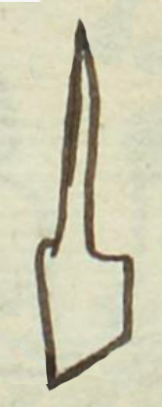huictli (MH552r)
This black-line drawing of the element representing a (huictli) shows a frontal view of an agricultural tool for digging. It is vertical and resembles a shovel (perhaps showing some European influence over the autonomous-era digging stick), as it seems to have a wider blade than usual. This tool has been carved from the compound hieroglyph for the personal name Tetl Ihuic.
Stephanie Wood
This may be what is called a "bladed coa" in a study of Xochimilco from 1966, although it is said to be "triangular." [See: Robert Cooper West and John P. Augelli, Middle America; Its Lands and Peoples (1966, 243).] An iron bladed digging stick had the name tepozhuictli. [See: James Lockhart, The Nahuas, 1922, 531.] This represents clear colonial change.
Evidence that the huictli came to be called a coa in Mexican Spanish comes from the Spanish-language text in the Florentine Codex.
Stephanie Wood
1560
Stephanie Wood
tools, herramientas, agricultura

huic(tli), a digging stick with a flat blade, https://nahuatl.wired-humanities.org/content/huictli
una herramienta agrícola
Stephanie Wood
Matrícula de Huexotzinco, folio 552r, World Digital Library. https://www.loc.gov/resource/gdcwdl.wdl_15282/?sp=183&st=image
This manuscript is hosted by the Library of Congress and the World Digital Library; used here with the Creative Commons, “Attribution-NonCommercial-ShareAlike 3.0 License” (CC-BY-NC-SAq 3.0).



